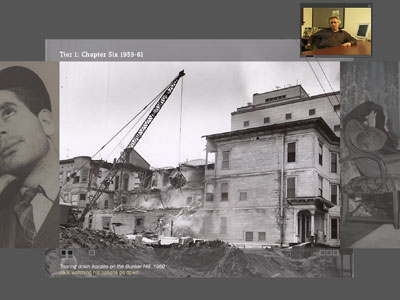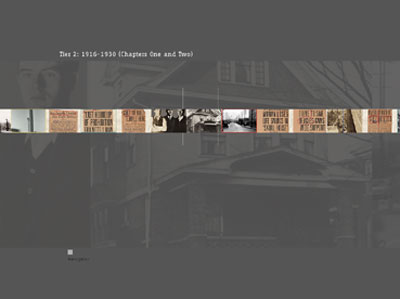|
|
|||||
|
BLEEDING THROUGH |
|||||
LABYRINTH PROJECT The
Labyrinth Project is an art collective and research initiative on
interactive cinema and database narrative at the University of Southern
California’s Annenberg Center for Communication. Under the
direction of cultural theorist Marsha Kinder since 1997, this initiative
works at the pressure point between theory and practice. After hosting
“Interactive Frictions,” a groundbreaking international
conference and exhibition at USC in 1999, Kinder decided to focus
on producing interactive narratives and installations in collaboration
with visual artists and writers known for their experimentation
with nonlinear forms. She assembled a group of talented digital
artists --headed by Rosemary Comella, Kristy H.A. Kang, Scott Mahoy
and associate producer and curator JoAnn Hanley--to oversee these
productions. These collaborations also involve the participation
of talented students from several divisions within USC’s School
of Cinema-Television--animation, critical studies, interactive media,
and production. No matter whether our primary collaborator is a
filmmaker or writer, we choose to make our projects cinematic. For,
Labyrinth is committed to creating a productive dialogue between
the immersive language of cinema and the interactive potential and
database structures of digital media. NORMAN
M. KLEIN |
Article (SF Gate, 18 sept 2003) Texte en anglais Bleeding
Through: Layers of Los Angeles, 1920-1986 is an interactive narrative
that combines a database detective story with a digital city symphony
and a metanarrative reflection on storytelling in this new medium. Set
in a three-mile radius near downtown Los Angeles, this DVD-ROM explores
Boyle Heights, Bunker Hill, Chavez Ravine, Chinatown, Echo Park, Little
Tokyo and other contested locations that helped shape the city’s
cultural history. These ethnically complex neighborhoods are documented
through archival photographs and films and through contemporary images
that either reproduce or evoke them. This DVD- ROM is accompanied by
a book, which contains a novella by cultural historian Norman M. Klein
and essays on the production by Jeffrey Shaw, Marsha Kinder, Rosemary
Comella and Andreas Kratky.
The interface enables the narrative to be navigated in three ways. Positioned within a small window, author Norman Klein tells the story of Molly, the fictional protagonist of his novella who is based on a real life person and who may have murdered one of her husbands. He invites us to collaborate with him in writing this fictional life. Or we can explore what Molly never noticed—the back stories of real life people whose mini-memoirs preserve histories that otherwise might have been lost. And finally, the project leads us to reflect on this act of database storytelling and its cultural implications, particularly when set within L.A.’s urban dream factory. The contrast between past and present is most dramatic and uncanny in the back stories, where one can slide fluidly between “bleed-throughs”—old and new photographs of the same cityscape taken from precisely the same angle—which enable us to make buildings instantaneously emerge or vanish.
Drawing on hundreds of photographs, newspaper clippings and films from the archives of USC, the Los Angeles Public Library and the Automobile Club of Southern California with additional material from personal collections, “Bleeding Through” helps us refigure our vision of Los Angeles, particularly if it has been based primarily on representations from Hollywood mainstream movies.
|
||||
|
|||||



